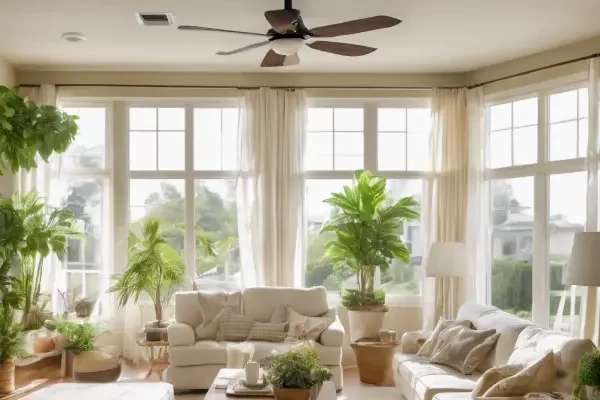Mold is a prevalent issue in both residential and commercial properties, capable of causing structural harm and posing health risks to occupants. Ensuring proper ventilation is essential in maintaining optimal indoor humidity levels and minimizing the chances of mold development.
The comprehensive analysis presented below emphasizes the advantages of implementing adequate ventilation measures for mold prevention in both residential and commercial environments.
Moisture Regulation
Ventilation systems play a crucial role in balancing indoor humidity levels. The growth of mold is mainly caused by an excess of moisture. By promoting a steady flow of air, these systems prevent the build-up of dampness within a structure. This control of moisture decreases the likelihood of mold formation and spreading.
Improved Air Quality
Mold spores easily spread in the air, causing harmful effects on the quality of indoor air. Sufficient ventilation is important as it allows for the circulation of fresh outdoor air, which helps reduce and eliminate mold spores that are floating in the air. This circulation plays a crucial role in creating a healthier environment for people to breathe in.
Temperature Control
Alongside the regulation of humidity, ventilation assists in maintaining even temperature distribution within a building. Extreme temperature variances can contribute to condensation and moisture issues that enable mold growth. Good ventilation prevents these hot or cold spots from developing, thereby deterring mold formation.
Extended Building Longevity
When mold takes hold in a building, it can cause serious damage to materials such as wood, drywall, and insulation. By preventing mold growth through proper ventilation, the lifespan of these materials is significantly extended, thereby protecting the building’s structural integrity and value.
Energy Efficiency
Modern ventilation systems, particularly energy recovery ventilators (ERVs) and heat recovery ventilators (HRVs), not only promote air circulation but also improve energy efficiency. These systems recover energy from exhaust air and use it to condition incoming fresh air, which can lead to heating and cooling cost savings while still preventing mold.
Health Benefits
Occupants of a building can experience improved health directly through the lessening of mold. Mold exposure can result in respiratory problems, allergic reactions, and various other health complications. By ensuring proper ventilation, the potential hazards associated with mold can be minimized, therefore promoting a healthy environment.
Odor Reduction
Mold is often associated with musty odors that can permeate a building. Good ventilation helps remove these odors, improving the overall comfort and atmosphere of the indoor environment.
Compliance with Regulations
Many regions have building codes and standards that require adequate ventilation to prevent health hazards, including those posed by mold. Ensuring a well-ventilated space keeps property owners in compliance with health and safety regulations.
Evidence in the Use of Ventilation with Mold Control
- Sarah’s Recovery Journey: A Success Story of Mold Sensitized Treatment
Sarah Forth, a long-time sufferer of mold sensitivity, shared her positive experience after working with one of our Remediation for Sensitized Individuals course graduates. After dealing with illness for nearly eight months, Sarah’s health improved significantly after implementing ventilation for mold control techniques.
It is unfortunate that the medical community has limited knowledge about mold sensitivity. As a result, doctors often overlook the symptoms associated with this condition. However, through proper ventilation and mold control measures, individuals like Sarah can find relief from their debilitating symptoms.
- John’s Office: A Mold-Free Workplace
John, a business owner, was faced with a persistent mold problem in his office building. The mold not only posed a health risk to his employees but also affected the overall productivity of the workplace. Seeking a solution, John opted for ventilation systems specifically designed to control and reduce mold growth.
By installing proper ventilation systems and maintaining regular inspections, John was able to create a mold-free workplace environment. This led to improved employee health and increased work efficiency, ensuring a healthy and productive atmosphere for his staff.
- Rebecca’s Home: A Breath of Fresh Air
Rebecca, a homeowner, had been struggling with mold growth in her basement for years. Despite numerous attempts at remediation, the mold problem kept coming back, causing health issues for her family. Determined to find a long-lasting solution, Rebecca discovered the benefits of ventilation for mold control.
Rebecca invested in a high-quality ventilation system designed to eliminate excess moisture and improve airflow throughout her home. As a result, the mold growth in her basement was effectively controlled. Rebecca and her family experienced a noticeable improvement in their respiratory health and were able to enjoy a clean and mold-free living space.
- Anderson Corporation: Mold Prevention for a Manufacturing Facility
The Anderson Corporation, a leading manufacturing company, faced significant challenges with mold growth within their production facility. Mold contamination not only affected the quality of their products but also posed serious health risks to their employees. Seeking a comprehensive solution, Anderson Corporation turned to ventilation systems for mold prevention.
By implementing advanced ventilation systems throughout their facility, the company effectively controlled moisture levels and improved air circulation. This successful mold control strategy resulted in improved product quality and ensured a safe working environment for the employees.
- Green Solutions Spa: Providing a Healthy Environment for Guests
Green Solutions Spa, a popular wellness retreat, understood the importance of creating a healthy and mold-free environment for their guests. Recognizing the potential health risks associated with mold, the spa invested in top-of-the-line ventilation systems to ensure optimal air quality.
By utilizing ventilation systems specifically designed for mold control, Green Solutions Spa successfully created a safe and inviting atmosphere for guests. The effective control of mold growth not only enhanced the overall experience for spa visitors but also ensured their well-being during their stay.
Conclusion
Investing in a good ventilation system is a vital step toward mold control in both residential and commercial buildings. It not only prevents mold growth by controlling indoor humidity levels but also contributes to a more comfortable, healthier, and energy-efficient environment. Property owners and managers should regularly assess and maintain their ventilation systems to ensure optimum performance in mold prevention.
Implementing ventilation strategies, such as natural ventilation or mechanical ventilation systems with ERVs or HRVs, should be considered an integral part of any comprehensive mold control plan. If necessary, consulting with HVAC professionals or building scientists might provide additional insights into custom solutions for specific building needs.

